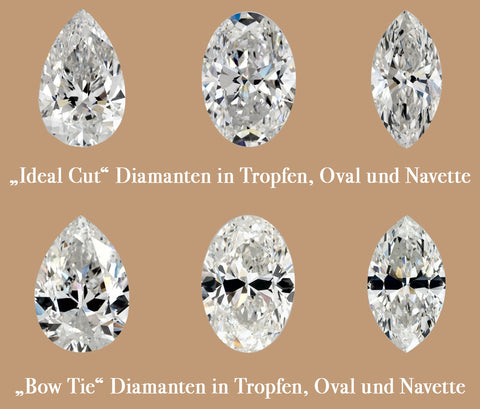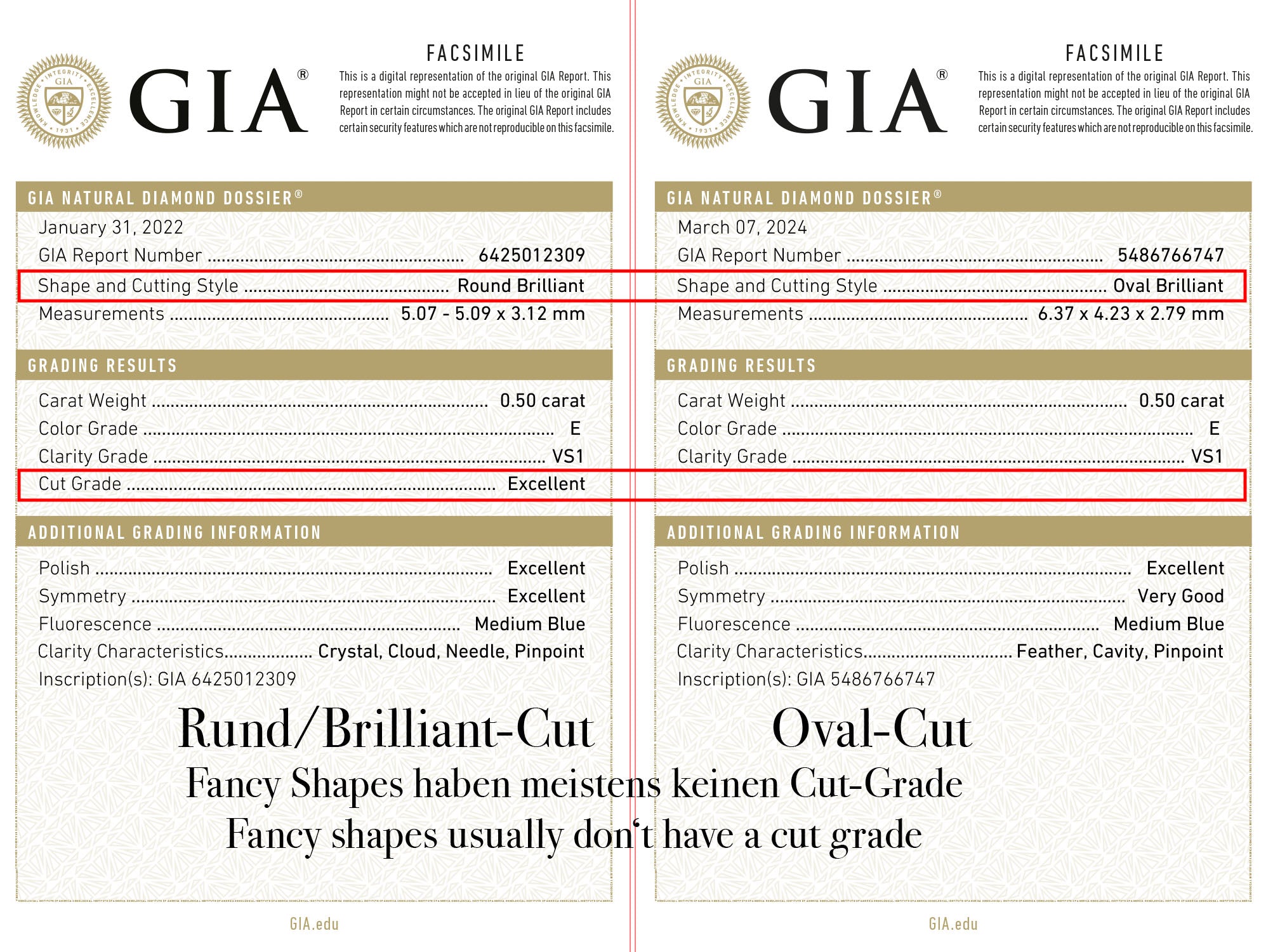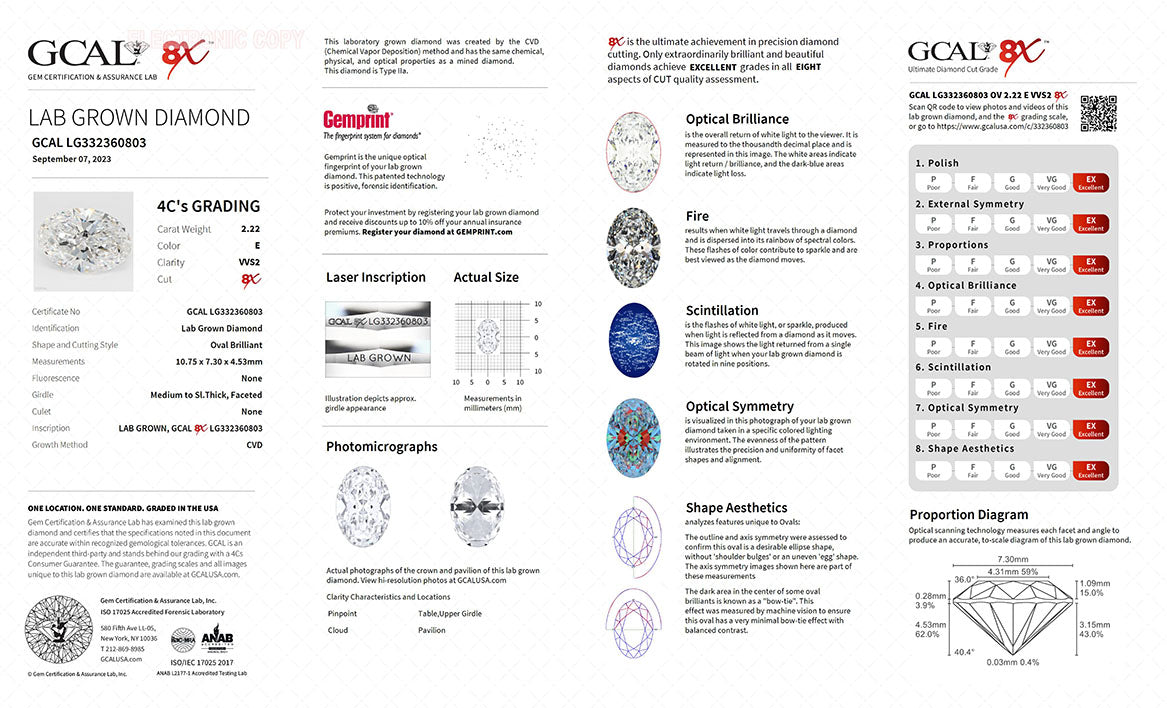
The name "Bow Tie Effect" in diamonds comes from the bow tie like worn with a tuxedo. It is an optical phenomenon that looks like a tuxedo bow tie in diamonds. It mainly occurs in diamonds with a longer ratio of length to width. Classic examples for this are Pear, Oval, or Marquise cuts. The effect can vary in intensity: from dark to black areas, a slight shadow, or even invisible.
A Bow Tie has nothing to do with the purity of a diamond. It's all about the cut quality (CUT) and how the symmetry of the cut affects the angles of the different areas or facets in terms of light refraction.
Even though it appears so, the Bow Tie is an internal characteristic of the diamond that has nothing to do with purity.
Those looking for an engagement ring with a Pear, Oval, or Marquise diamond will most likely encounter a Bow Tie. The mentioned cuts tend to this effect and it is difficult to avoid. Designer Diamonds in Munich and Augsburg always search for diamonds that a minimized or even no bow tie effect.
Diamonds with elongated shapes (Oval, Pear, Marquise, Radiant, elongated Cushion Cut) should ideally reflect light through the entire table to ensure a lively sparkle. Diamond facets act like a mirror, hence the brightest stones throw all their absorbed light from the pavilion upwards. If their facets are perfectly polished, they allow the diamond to absorb and refract the maximum amount of light. The perfect polish also ensures high transparency. This creates that intense shine that everyone finds so appealing and for which diamonds are known.
As a rule of thumb: The less Bow-Tie the diamond has, the more it will sparkle.
 |
| As can be seen in the picture, you can recognize the comparison between the elongated diamonds that show more pronounced Bow-Ties. It's clear how much whiter and brighter an ideally cut diamond appears. |
Should you buy a diamond with a Bow-Tie?
Bow-Ties are not necessarily bad: If they are more subtle, like a faint shadow, this can have little to no impact on the beauty of the diamond. Also remember that what is considered disturbing to the appearance of the diamond and quite obvious to one person might not be the case for another. However, we recommend avoiding strong Bow-Ties with heavily darkened areas. This type of Bow-Tie darkens most of the diamond and makes it look dull and cloudy. By minimizing this effect, your diamond will look brighter, appear larger, and be more valuable. The most appealing elongated diamonds show no or less noticeable Bow-Ties.
If you want a diamond that is bright, sparkling, and has excellent optical properties and creates the greatest wow effect, we recommend prioritizing diamonds with ideal cut grades. They are cut and processed to maximize brilliance and minimize the Bow-Tie effect. You can have a flawless diamond, but if it has a poor cut, it will distract from its overall beauty. Never neglect the impact of the diamond's cut quality (CUT).
 |
| Here you can see the comparison of a certificate for a brilliant cut and one for an oval diamond. The Cut-Grade is missing here, as there are no uniform standards for these cuts. |
 |
| Certificates like GCAL 8X or IGI now provide these. However, caution is advised as just from the data alone a Bow Tie cannot be excluded. |
Important: Diamond labs like GIA, IGI, or HRD only assign the "CUT-Grade" for round diamonds. There are now some diamond labs like GCAL that also offer a Super-Ideal-Cut for Fancy-Shapes (e.g., GCAL's 8X). But: A diamond certificate is NEVER a guarantee of its beauty, sparkle, or a clear crystal structure. Only an experienced gemologist like those at Designer Diamonds in Munich and Augsburg can determine the most beautiful diamonds. Further information on "Do I really need a diamond certificate" can be found here.
How do I know if the diamond has a Bow-Tie?
Diamond certificates provide valuable information about a diamond's cut, including its symmetry and polish, but usually do not contain information about whether a diamond will have a Bow-Tie or not. This essential information is a key factor in determining if a diamond is truly beautiful. Only an experienced diamond expert and gemologist can read and interpret these data.
Therefore, it's even more important that the diamond is viewed in person. If this is not possible, only an expert can properly view an image and analyze the certificate data. Most pictures shown by online retailers are edited and photographed to hide the Bow-Tie. Generally, it's therefore not recommended to buy a diamond online because its beauty cannot be judged. Otherwise, you risk buying an ugly diamond. A clear black Bow-Tie is not a characteristic of a beautiful diamond. It darkens it and casts a large Bow-Tie shadow across the entire diamond, reducing its shine.
Rule of thumb: Without a visual inspection, you rely solely on the information provided by a selection of certificates and online videos, which do not always show the Bow-Tie effect. There's no guarantee that the diamond won't have some level of Bow-Tie quality. Depending on the angle, a Bow-Tie may not always be clearly visible in a video, and you won't find details about it on a diamond report. An expert can help you with this!
Not every diamond shape is affected by the Bow-Tie effect. For those who prefer a round brilliant cut, the Bow-Tie poses no problems. Diamonds that are symmetrical in their proportions and have a 1:1 ratio (Round/Brilliant cut, Princess-Cut, Cushion) cannot produce a Bow-Tie effect.
Conclusion: Fancy Shapes are harder to buy than Round - An expert can help
The most coveted diamonds are those that reflect and refract light in countless directions to create a beautiful fire. Any feature that impairs a diamond's shine or obstructs its light reflection is less desirable. Therefore, the Bow-Tie effect is a characteristic that should be minimized as much as possible so it has little impact on the appearance of the diamond and remains appealing.
The dark patterns of the Bow-Tie can actually detract from an otherwise beautiful diamond and pull it down. Diamonds are known for their stunning shine and their symphony of facets that reflect and refract light in fascinating ways. Therefore, we recommend avoiding anything that hinders this beautiful shimmer or distracts from it, as shine and brightness are integral parts of the true appeal of a diamond.

